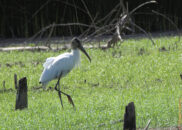Today our feature pic is a group of birds. Due to the poor angle of the light and the distance (800mm lens), it is not a very good picture. But what surprised me greatly while I was taking it, was the odd large bird you see in the middle. I had never seen its kind. I researched and found out it was a wood stork. The wikipedia map shows there is only a small area in southern California where they will go during the winter. These pics were taken on June 1st. So, his/her presence is even more unusual at this time of the year.
Then, a couple of days later, I saw comments in my favorite wildlife photography group in Facebook about the excitement about this unique visitor in our area. So, once again, Lady Luck smiled at me, yeah!!


All the other pictures in our gallery today were taken on the very same day. One might call it a very productive day. But don’t go thinking that I get so many good pictures every time I go hiking in the wilderness. I sometimes come back with only a few bad pictures and that’s fine, it’s part of the deal. As a photographer, you only need to always be on the lookout for something to happen, and be ready to catch at least one good photo when nature chooses to give it to you.
Anyway, enough talk about my views on wildlife photography. Here is a list of the other birds in the gallery:
Great egret
Snowy egret
Black-necked stilt
American avocet
White-faced ibis
American bushtit
That day I also got a few pics of a northern harrier but there were not as good as those I posted just last week.
Coming back to our wood stork, let’s look at this bird in further details. As the wikipedia map shows it is normally a resident in south and central America and the Caribbean.
Here are a few interesting facts about this bird:
- They nest in colonies, building nests on trees top in Florida’s wetlands.
- The male will build the nest.
- Some wood stork will take over other’s nests, throwing out eggs or young.
- This is yet another fish eater, although they will also eat crabs, frogs, and insects.
- It will excrete on its legs to help with thermoregulation. (huh… isn’t that strange?)
- This is a quiet bird. It will only make hissing noises.
- They can live up to 18 years. However, according to the Florida Fish & Wildlife commission, one individual lived 27 years in captivity.
- A group of storks is called a muster, but a group of storks in flight has yet another name: a phalanx (why do we have to make things so complicated?)






